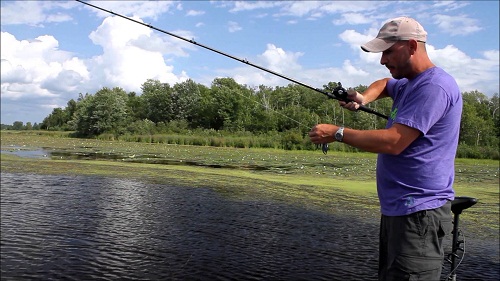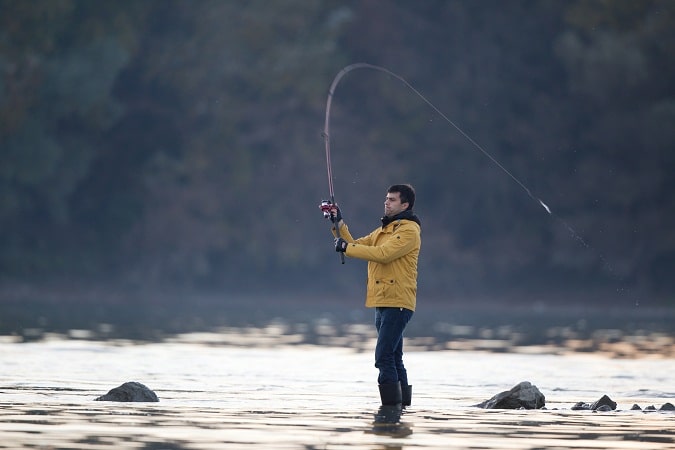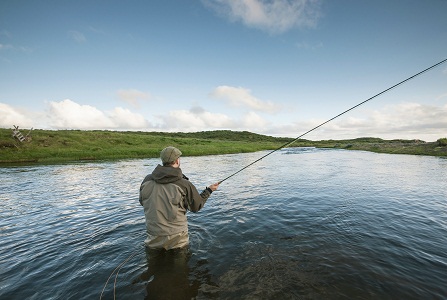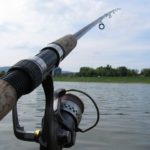If you want to catch fish, you need to sling your lure out to where the lunkers lurk regardless of the species you are targeting, the methods you intend to employ, or the fishing rod you plan to use.
There are a various casting techniques that you can use and it’s important to match it with the circumstances.
3 Basic Casting Techniques Every Angler Should Know
At the outset, you want to learn the simplest ways to cast before trying more complicated and difficult methods. By mastering these three techniques, you will be prepared for most fishing situations.
We used the clock face to reference the rod positions.
Overhead Cast
- Begin by reeling in the lure until there are about 12 to 24 inches of free line extending from the rod tip.
- With the spool free and your thumb on the line (if you are using a bait caster), or the bail open and your finger on the line (if you are using spinning gear), draw the rod back over your head until it points behind you at 10:00.
- At the very instant you reach the end of your back swing, start bringing the rod forward quickly. This helps load the rod with the weight of the lure, causing it to bend from the force.
- Release the line or remove your thumb from the spool when the rod is at 12:00. But be sure that you follow through and bring your rod all the way to 2:00 at the end of the cast.
You can use the overhead cast for just about any lure imaginable. It works best when you can cast well beyond the fish as it often causes a large splash when the lure hits the water.
Sidearm Cast
The only striking difference between a sidearm and an overhead cast is the angle in which you swing the rod – everything else is the same. A sidearm cast produces much less splash than the latter, so it is preferred for most fishing situations.
The difficult part of learning to cast sidearm is accuracy. It can be tough to place your lure in the ideal spot when you are still a beginner with the technique. But with practice, your accuracy will improve and you’ll be able to hit a tiny target when needed.
Drop Cast
A drop cast is used when fishing off a pier or other object high above the water. Fishing in these situations usually means that you cannot cast very far out so you’ll be limited to fishing directly below you.
It is pretty easy to cast straight down – you only need to open the bail or free the spool and watch your lure plummet. However, it is wise to slow or stop the spool before the lure hits the water to avoid a fish-frightening splash.
3 Advanced Casting Techniques
Once you’ve mastered the basic casting techniques, it is time to learn a few advanced methods for getting your lure in front of the fish. Many require considerable practice to become proficient, but it is worth the effort to learn how to perform each of the following:
Pitching

Pitching is a technique for casting intermediate distances at isolated patches of cover. Here’s how it is done.
- Grab the lure in your off hand, and then point your rod tip down on the water.
- With a smooth, quick motion, the lure tip is raised so the lure flies forward. At the same time, you need to release the spool so the lure pulls the line free.
- Use your thumb to stop the spindle so the lure stops moving right before it hits the water, thereby reducing the splash created.
Pitching is used when fishing with jigs or soft plastic baits. It is often done along weed lines or overhanging vegetation near the shore.
Flipping
Flipping is a short-range method used to target fish in extremely tight spaces. Below are the steps.
- Release the spool and let out about 15 feet of line, and then re-engage the spool – this is all the line that you’re going to use when flipping.
- With your off hand, pull the line between the reel and the first rod guide. This allows the lure to swing freely from the end of your rod tip.
- Using a pendulum-like motion, swing the lure out toward the target, releasing the line from your off hand to allow it to fly freely.
Like pitching, flipping is usually done with soft-plastic baits or jigs. It is commonly used in dense weed beds and other types of thick cover when the fish may be spooked by a lure crashing into the surface.
Skipping
Skipping is a technique that is useful for getting your lure under docks or overhanging vegetation. It requires a sidearm casting method. But instead of sending the lure on a trajectory that keeps it a few feet above the water, you sling the lure right at water level.
When performed effectively, it will cause the lure to skip across the surface of the water. Many anglers use soft plastic lures, mainly stick baits, when skipping; and others use top water lures or crankbaits.
The only limit is your imagination and skill level.
Practice to Level Up!
Don’t let these various casting strategies overwhelm you, particularly if you just begun learning to fish. Spend a little time mastering the basic techniques and then start working the advanced methods into your repertoire.
While it is always helpful to have a variety of casting methods in your fishing quiver, some anglers may never need to learn how to flip or pitch, for example.
With time and practice, you’ll be surprised just how quickly you can learn these techniques. Before you know it, you’ll be using them on the water without even thinking about it.







